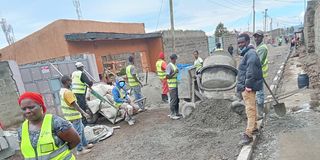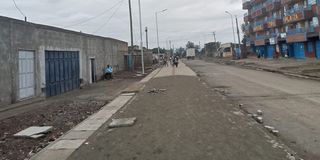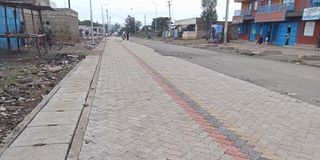My Hood: New development projects draw investors to Murogi estate

Construction workers build drainage systems in Murogi estate on November 8, 2024.
Murogi estate in Nakuru East is one of the most despised areas in Nakuru county due to the many vices that it is associated with, including illicit liquor, insecurity and poverty.
For this reason, the area is always shunned especially by the middle class who would want nothing to do with it.
The choice of the name Murogi has also sparked controversy with efforts being made to change it in a bid to change the perception of the residents who believe the area is condemned.
To worsen the situation, an influx of the dreaded confirm gang members in the slum area after they were flushed from their original bases in Flamingo and Bondeni has contributed in tainting the image of the area.
However, there has been a rare change of things in the recent past. Major investments are being made in the estate with businessmen daring to run businesses in the estate where no one was ready to risk their fortunes.

A newly constructed tarmac road that has changed the face of Murogi estate.
Land owners are now constructing trading centres along the street.
The groups of weird looking youth in jobless corners can no longer be seen easily as the majority have been engaged in a slum upgrade project that is being jointly implemented by the World bank in partnership with the county government.
Major and linkage roads in the estate are being upgraded and the locals have been engaged to offer manpower.
Mr Francis Maina says the project which began last year has had a massive impact in the social and economic development in the estate.
“This place was dangerous as you could be mugged in broad daylight. The shops used to close by 7 pm and no one would dare walk along these roads alone at night without being attacked and robbed,” says Mr Maina.
He notes that there has been increased economic activities characterized with new shops being opened as well as hawkers and food venders frequenting the estates.
According to Mr Maina, insecurity and poor state of roads had discouraged entrepreneurs from setting up their shops in the area but after they saw the upgrading of the roads and erection of the security light masts, many have started positioning themselves strategically for better tidings in future.

A newly constructed non motorized transport in Murogi estate. Photo taken on November 8, 2024.
In an area where single roomed mud walled rentals are the most preferred by tenants, one investor has risked to set up a flat with tens of two and three bedroomed housing units.
“Immediately the project started, the value of land in this area shot up, new investors started showing interest to purchase while landlords began improving their houses,” says Mr Maina.
Ms Grace commonly known as mama Sammy is one of the residents who got a casual job at the project site. She explains how the job has turned around her life.
“I used to sell a kiosk which never used to sell so when I saw the project I decided to look for a job which I was lucky to get. I am now able to complement my husband in the family expenses while at the same time save part of the wage with my chama,” says Grace.
The project known as Kenya Informal Settlement Improvement project KISIP) is being implemented in different settlements in the county including Murogi, Hilton, Lakeview and Karagita.
Mr Kamau Kuria who is the chief officer for Housing and Urban development says the project is part of a comprehensive regeneration program for the urban areas, being done by the county government under the leadership of governor Susan Kihika.
“The project is in its second phase where it involves construction of drainage systems, installation of security lights as well as improvement of roads and sewer systems,” says Mr Kuria.
The project which is expected to be completed by February will cost Sh 650 million before the next phase begins.
The next cycle according to him will target the areas of Tayari in Molo, Kiratina in Nakuru East, Mwisho wa lami in Njoro and Kapkures in Nakuru East.
At least Sh 800 million will be required to complete the phase by the year 2027.
